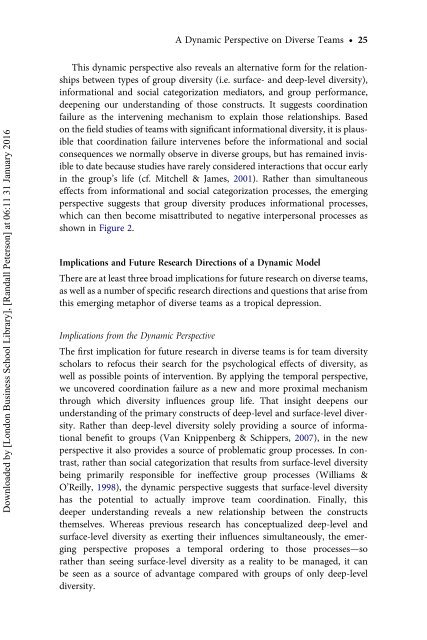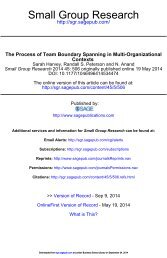A Dynamic Perspective on Diverse Teams: Moving From The Dual Process Model to A Dynamic Coordination-Based Model of Diverse Team Performance - Kannan Srikanth, Sarah Harvey & Randall Peterson
The existing literature on diverse teams suggests that diversity is both helpful to teams in making more information available and encouraging creativity and damaging to teams in reducing cohesion and information sharing. Thus the extant literature suggests that diversity within teams is a double-edged sword that leads to both positive and negative effects simultaneously.
The existing literature on diverse teams suggests that diversity is both helpful to teams in making more information available and encouraging creativity and
damaging to teams in reducing cohesion and information sharing. Thus the
extant literature suggests that diversity within teams is a double-edged sword
that leads to both positive and negative effects simultaneously.
You also want an ePaper? Increase the reach of your titles
YUMPU automatically turns print PDFs into web optimized ePapers that Google loves.
A <str<strong>on</strong>g>Dynamic</str<strong>on</strong>g> <str<strong>on</strong>g>Perspective</str<strong>on</strong>g> <strong>on</strong> <strong>Diverse</strong> <strong><strong>Team</strong>s</strong> † 25<br />
Downloaded by [L<strong>on</strong>d<strong>on</strong> Business School Library], [<strong>Randall</strong> Peters<strong>on</strong>] at 06:11 31 January 2016<br />
This dynamic perspective also reveals an alternative form for the relati<strong>on</strong>ships<br />
between types <strong>of</strong> group diversity (i.e. surface- and deep-level diversity),<br />
informati<strong>on</strong>al and social categorizati<strong>on</strong> media<strong>to</strong>rs, and group performance,<br />
deepening our understanding <strong>of</strong> those c<strong>on</strong>structs. It suggests coordinati<strong>on</strong><br />
failure as the intervening mechanism <strong>to</strong> explain those relati<strong>on</strong>ships. <strong>Based</strong><br />
<strong>on</strong> the field studies <strong>of</strong> teams with significant informati<strong>on</strong>al diversity, it is plausible<br />
that coordinati<strong>on</strong> failure intervenes before the informati<strong>on</strong>al and social<br />
c<strong>on</strong>sequences we normally observe in diverse groups, but has remained invisible<br />
<strong>to</strong> date because studies have rarely c<strong>on</strong>sidered interacti<strong>on</strong>s that occur early<br />
in the group’s life (cf. Mitchell & James, 2001). Rather than simultaneous<br />
effects from informati<strong>on</strong>al and social categorizati<strong>on</strong> processes, the emerging<br />
perspective suggests that group diversity produces informati<strong>on</strong>al processes,<br />
which can then become misattributed <strong>to</strong> negative interpers<strong>on</strong>al processes as<br />
shown in Figure 2.<br />
Implicati<strong>on</strong>s and Future Research Directi<strong>on</strong>s <strong>of</strong> a <str<strong>on</strong>g>Dynamic</str<strong>on</strong>g> <strong>Model</strong><br />
<strong>The</strong>re are at least three broad implicati<strong>on</strong>s for future research <strong>on</strong> diverse teams,<br />
as well as a number <strong>of</strong> specific research directi<strong>on</strong>s and questi<strong>on</strong>s that arise from<br />
this emerging metaphor <strong>of</strong> diverse teams as a tropical depressi<strong>on</strong>.<br />
Implicati<strong>on</strong>s from the <str<strong>on</strong>g>Dynamic</str<strong>on</strong>g> <str<strong>on</strong>g>Perspective</str<strong>on</strong>g><br />
<strong>The</strong> first implicati<strong>on</strong> for future research in diverse teams is for team diversity<br />
scholars <strong>to</strong> refocus their search for the psychological effects <strong>of</strong> diversity, as<br />
well as possible points <strong>of</strong> interventi<strong>on</strong>. By applying the temporal perspective,<br />
we uncovered coordinati<strong>on</strong> failure as a new and more proximal mechanism<br />
through which diversity influences group life. That insight deepens our<br />
understanding <strong>of</strong> the primary c<strong>on</strong>structs <strong>of</strong> deep-level and surface-level diversity.<br />
Rather than deep-level diversity solely providing a source <strong>of</strong> informati<strong>on</strong>al<br />
benefit <strong>to</strong> groups (Van Knippenberg & Schippers, 2007), in the new<br />
perspective it also provides a source <strong>of</strong> problematic group processes. In c<strong>on</strong>trast,<br />
rather than social categorizati<strong>on</strong> that results from surface-level diversity<br />
being primarily resp<strong>on</strong>sible for ineffective group processes (Williams &<br />
O’Reilly, 1998), the dynamic perspective suggests that surface-level diversity<br />
has the potential <strong>to</strong> actually improve team coordinati<strong>on</strong>. Finally, this<br />
deeper understanding reveals a new relati<strong>on</strong>ship between the c<strong>on</strong>structs<br />
themselves. Whereas previous research has c<strong>on</strong>ceptualized deep-level and<br />
surface-level diversity as exerting their influences simultaneously, the emerging<br />
perspective proposes a temporal ordering <strong>to</strong> those processes—so<br />
rather than seeing surface-level diversity as a reality <strong>to</strong> be managed, it can<br />
be seen as a source <strong>of</strong> advantage compared with groups <strong>of</strong> <strong>on</strong>ly deep-level<br />
diversity.
















